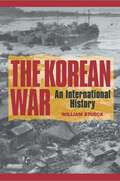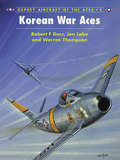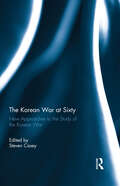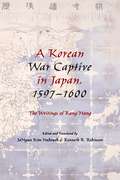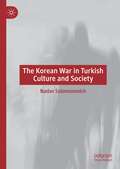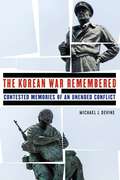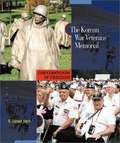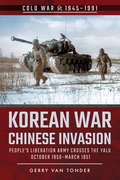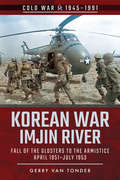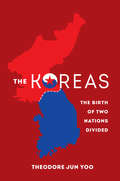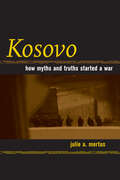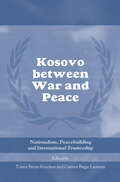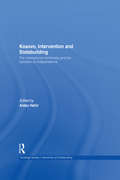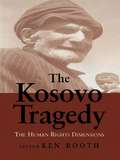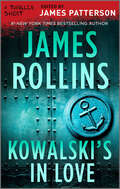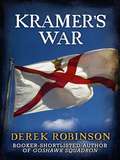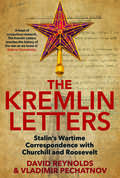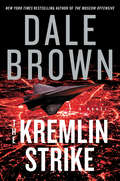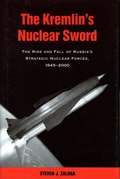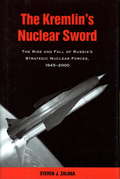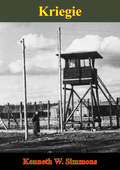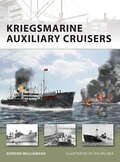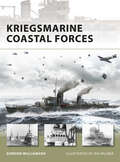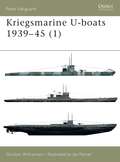- Table View
- List View
The Korean War: An International History (Princeton Studies in International History and Politics #68)
by William StueckThis first truly international history of the Korean War argues that by its timing, its course, and its outcome it functioned as a substitute for World War III. Stueck draws on recently available materials from seven countries, plus the archives of the United Nations, presenting a detailed narrative of the diplomacy of the conflict and a broad assessment of its critical role in the Cold War. He emphasizes the contribution of the United Nations, which at several key points in the conflict provided an important institutional framework within which less powerful nations were able to restrain the aggressive tendencies of the United States. In Stueck's view, contributors to the U.N. cause in Korea provided support not out of any abstract commitment to a universal system of collective security but because they saw an opportunity to influence U.S. policy. Chinese intervention in Korea in the fall of 1950 brought with it the threat of world war, but at that time and in other instances prior to the armistice in July 1953, America's NATO allies and Third World neutrals succeeded in curbing American adventurism. While conceding the tragic and brutal nature of the war, Stueck suggests that it helped to prevent the occurrence of an even more destructive conflict in Europe.
Korean War Aces
by Chris Davey Robert DorrThe first virtually all-jet war, the conflict in Korea saw F-86 Sabres of the USAF take on MiG-15s of the North Korean and Chinese air forces. Although the Allied pilots were initially taken aback by the ability of the communist fighter in combat, sound training and skilful leadership soon enabled Sabre pilots to dominate the dogfights over the Yalu River. In all 39 F-86 pilots achieved ace status, and a number of these are profiled in this volume, as are notable pilots from the US Navy, Marine Corps and Royal Navy and, for the first time, the handful of MiG-15 aces.
The Korean War at Sixty: New Approaches to the Study of the Korean War
by Steven CaseyKorea used to be the ‘forgotten war.’ Now, however, experts widely view it as a pivotal moment in the history of the Cold War, while its legacy still scars contemporary East Asian politics. The sixtieth anniversary of the Korean War is a fitting time both to assess the current state of historiography on the conflict and to showcase new research on its different dimensions. This book contains six essays by leading experts in the field. These essays explore all aspects of the war, from collective security and alliance relations, to home front politics and historical memory. They are also international in scope, focusing not just on the familiar Western belligerents but also on the actions of the two Koreas, China and the Soviet Union. These stimulating essays shed new light on various aspects of the Korean War experience, as well as examining why the war remains so important to the politics of the region. This book was originally published as a special issue of Journal of Strategic Studies.
A Korean War Captive in Japan, 1597–1600: The Writings of Kang Hang
by Kenneth Robinson JaHyun Kim HaboushKang Hang was a Korean scholar-official taken prisoner in 1597 by an invading Japanese army during the Imjin War of 1592–1598. While in captivity in Japan, Kang recorded his thoughts on human civilization, war, and the enemy's culture and society, acting in effect as a spy for his king. Arranged and printed in the seventeenth century as Kanyangnok, or The Record of a Shepherd, Kang's writings were extremely valuable to his government, offering new perspective on a society few Koreans had encountered in 150 years and new information on Japanese politics, culture, and military organization.In this complete, annotated translation of Kanyangnok, Kang ruminates on human behavior and the nature of loyalty during a time of war. A neo-Confucianist with a deep knowledge of Chinese philosophy and history, Kang drew a distinct line between the Confucian values of his world, which distinguished self, family, king, and country, and a foreign culture that practiced invasion and capture, and, in his view, was largely incapable of civilization. Relating the experiences of a former official who played an exceptional role in wartime and the rare voice of a Korean speaking plainly and insightfully on war and captivity, this volume enables a deeper appreciation of the phenomenon of war at home and abroad.
The Korean War in Turkish Culture and Society
by Nadav SolomonovichThis book explores the important role that the Korean War played in Turkish culture and society in the 1950s. Despite the fact that fewer than 15,000 Turkish soldiers served in Korea, this study shows that the Turkish public was exposed to the war in an unprecedented manner, considering the relatively small size of the country’s military contribution. It examines how the Turkish people understood the war and its causes, how propaganda was used to ‘sell’ the war to the public, and the impact of these messages on the Turkish public. Drawing on literary and visual sources, including archival documents, newspapers, protocols of parliamentary sessions, books, poems, plays, memoirs, cartoons and films, the book shows how the propaganda employed by the state and other influential civic groups in Turkey aimed to shape public opinion regarding the Korean War. It explores why this mattered to Turkish politicians, viewing this as instrumental in achieving the country’s admission to NATO, and why it mattered to Turkish people more widely, seeing instead a war in the name of universal ideas of freedom, humanity and justice, and comparing the Turkish case to other states that participated in the war.
The Korean War Remembered: Contested Memories of an Unended Conflict (Studies in War, Society, and the Military)
by Michael J. DevineMichael J. Devine provides a fresh, wide-ranging, and international perspective on the contested memory of the 1950–1953 conflict that left the Korean Peninsula divided along a heavily fortified demilitarized zone. His work examines &“theaters of memory,&” including literature, popular culture, public education efforts, monuments, and museums in the United States, China, and the two Koreas, to explain how contested memories have evolved over decades and how they continue to shape the domestic and foreign policies of the countries still involved in this unresolved struggle for dominance and legitimacy. The Korean War Remembered also engages with the revisionist school of historians who, influenced by America&’s long nightmare in Vietnam, consider the Korean War an unwise U.S. interference in a civil war that should have been left to the Koreans to decide for themselves. As a former Peace Corps volunteer to Korea, a two-time senior Fulbright lecturer at Korean universities, and former director of the Harry S. Truman Presidential Library, Devine offers the unique perspective of a scholar with half a century of close ties to Korea and the Korean American community, as well as practical experience in the management of historical institutions.
The Korean War Veterans Memorial (Cornerstones of Freedom, 2nd Series)
by R. Conrad SteinThe Korean War is called the "Forgotten War." The conflict was largely ignored by the American public while it raged. Even today the war is covered by only a few paragraphs, rather than a chapter, in the history books. But those who fought in Korea will never forget the terror and the misery they suffered there. For the rest of their lives they will have painful memories of friends who were killed in that faraway land.
Korean War—Chinese Invasion: People's Liberation Army Crosses the Yalu, October 1950–March 1951 (Cold War, 1945–1991)
by Gerry van TonderAn examination of the causes and the direct outcome of North Korea’s seemingly unstoppable thrust down the Korean Peninsula in 1950.In his first four volumes on the Korean War, the author traces the war’s progress from the North Korean invasion of June 1950, the desperate American defense of the Pusan Perimeter, General Douglas MacArthur’s daring and highly successful amphibious offensive at Inch’on, and his subsequent advance across the 38th Parallel to the Yalu River on the Chinese Manchurian borderCommunist Chinese forces, that have been secretly infiltrating North Korean territory by slipping across the Yalu from mid-October 1950, ambush a South Korean regiment in the mountains of central North Korea. This is the first of several Chinese victories over unsuspecting and overstretched South Korean and American units in the winter of 1950-1951.On November 27, 1950, Chinese leader Mao Zedong, ostensibly fearful of the consequences of hostile American forces on his country’s border along the Yalu River, orders 250,000 troops into Korea, with express orders to annihilate the UN forces. In the western half of the theater, U.S. General Walton H. Walker’s Eighth Army front along the Ch’ongch’on axis is breached, while to the east, the U.S. X Corps suffers a series of crushing defeats, including at the Chosin Reservoir, precipitating a massive evacuation from the North Korean port of Hungnam.Praise for Korean War - Chinese Invasion"An extraordinarily informative and exceptionally well written, deftly organized and presented, detailed history.” —Midwest Book Review
Korean War—Imjin River: Fall of the Glosters to the Armistice, April 1951–July 1953 (Cold War, 1945–1991)
by Gerry van TonderAn in-depth look at the disastrous consequences of misjudgment and impulsiveness by the United States during the Korean War.As of October 1950, a quarter of a million Communist Chinese troops, in twenty-seven divisions, had poured across the Yalu River into North Korea, with the singular objective of forcing General Douglas MacArthur’s United Nations troops back across the 38th Parallel and into the Sea of Japan.Shortly before midnight on April 22, 1951, to the west of the U.S. Eighth Army’s defensive front, the Chinese Sixty-third Army fell on the British 29th Brigade. On the left flank, the 1st Battalion, Gloucester Regiment (“Glosters”) held a tenuous position at a ford on the Imjin River. Despite a gallant defense, the battalion was pushed back to make a desperate but futile stand on Hill 235. On what became known as “Glosters’ Hill,” the battalion ceased to exist. It was subsequently estimated that the attacking force of 27,000 Chinese troops suffered 10,000 casualties, forcing the Chinese army to be withdrawn from the front.From August 1951 to the summer of 1952, the USAF conducted Operation Strangle in a futile and costly attempt to disrupt Chinese supply routes. In the last two years of fighting, Communist Chinese and UN forces faced each other from well-entrenched positions in hilly terrain, where mapped hill numbers were contested. From June 1952 to March 1953, a series of five hard-fought engagements took place in central Korea as the antagonists sought ownership of Hill 266, commonly referred to as “Old Baldy.” This was followed during April–July 1953 by two tactically pointless battles over Pork Chop Hill, in which the UN forces won the first battle and the Chinese the second, with both sides sustaining major casualties. On July 27, 1953, the two belligerents signed an armistice agreement, implementing a ceasefire that stands to this day. De facto, the Korean War has never ended.
The Koreas: The Birth of Two Nations Divided
by Theodore Jun YooWhat history, pop culture, and diaspora can teach us about North and South Korea today.Korea is one of the last divided countries in the world. Twins born of the Cold War, one is vilified as an isolated, impoverished, time-warped state with an abysmal human rights record and a reclusive leader who perennially threatens global security with his clandestine nuclear weapons program. The other is lauded as a thriving democratic and capitalist state with the thirteenth largest economy in the world and a model for developing countries to emulate. In The Koreas, Theodore Jun Yoo provides a compelling gateway to understanding the divergent developments of contemporary North and South Korea. In contrast to standard histories, Yoo examines the unique qualities of the Korean diaspora experience, challenging the master narratives of national culture, homogeneity, belongingness, and identity. This book draws from the latest research to present a decidedly demythologized history, with chapters focusing on feature stories that capture the key issues of the day as they affect popular culture and everyday life. The Koreas will be indispensable to any historian, armchair or otherwise, in need of a discerning and reliable guide to the region.
Kosovo: How Myths and Truths Started a War
by Julie A. MertusJulie Mertus provides one of the first comprehensive looks at the explosive situation in Kosovo, where years of simmering tensions between Serbs and Albanians erupted in armed conflict in 1998. In a profound and detailed study of national identity and ethnic conflict, Mertus demonstrates how myths and truths can start a war. She shows how our identity as individuals and as members of groups is defined through the telling and remembering of stories. Real or imagined, these stories shape our understanding of ourselves as heroes, martyrs, conquerors, or victims. Once we see ourselves as victims, Mertus claims, we feel morally justified to become perpetrators.Based on a series of interviews conducted in Kosovo, Serbia proper, and Macedonia, this book is one of the first extended treatments of the years leading to war in Kosovo. Mertus examines the formation of Serbian national identity, and closely scrutinizes the hostilities of the region. She shows how myth and experience inform the political ideologies of Kosovo, and explores how these competing beliefs are created and perpetuated. This sobering overview of the region provides a window into a complex struggle whose repercussions reach far into the international community.
Kosovo between War and Peace: Nationalism, Peacebuilding and International Trusteeship (Cass Series on Peacekeeping)
by Carsten Bagge Laustsen Tonny Brems KnudsenA major contribution to the debate about the reconstruction of Kosovo, and to the general discussion surrounding the revived 'trusteeship institution' model in the context of the UN internationalism of the 1990s and the War on Terror following 9/11. Bringing together leading international scholars, this book presents the latest empirical research alongside detailed theoretical analysis. Examining the key questions local parties and the international community have encountered in Kosovo, including how to develop effective and inclusive local government, how to counter crime and the dysfunctional aspects of liberal economic reform, how to unite the partly opposed goals of reconstructing the province while avoiding renewed ethnic and international strife, and how to handle the specific challenge of Kosovo’s future status. The contributors also re-examine the background factors that continue to influence and hamper the attempt to administrate and reconstruct the province, first of all the nationalist ideologies and the record of ethnic violence. This book will be of great interest to all students of Balkan politics, peacekeeping, international relations and security studies in general.
Kosovo, Intervention and Statebuilding: The International Community and the Transition to Independence (Routledge Studies in Intervention and Statebuilding)
by Aidan HehirThis book examines international engagement with Kosovo since NATO's intervention in 1999, and looks at the three distinct phases of Kosovo's development; intervention, statebuilding and independence. Kosovo remains a case study of central importance in international relations, illustrative of key political trends in the post-Cold War era. During each phase, international policy towards Kosovo has challenged prevailing international norms and pushed the boundaries of conventional wisdom. In each of the three phases 'Kosovo' has been cited as constituting a precedent, and this book explores the impact and the often troubling consequences and implications of these precedents. This book explicitly engages with this debate, which transcends Kosovo itself, and provides a critical analysis of the catalysts and consequences of contemporary international engagement with this seminal case study. Each chapter focuses on a particular aspect of the international engagement with Kosovo and situates events there in an international context, highlighting the extent to which international policy towards Kosovo has challenged existing norms and practices. Kosovo has been cited in certain texts as a positive template to be emulated, but the contributors to this book also identify the often controversial and contentious nature of these new norms. This book will be of much interest to students of humanitarian intervention and statebuilding, war and conflict studies, security studies and IR in general. Aidan Hehir is a Senior Lecturer in International Relations at the Department of Politics and International Relations, University of Westminster.
The Kosovo Tragedy: The Human Rights Dimensions
by Ken BoothThe 1999 conflict in Kosovo is seen as being as significant for international affairs as the pulling down of the Berlin Wall, because of the centrality of human rights in the build-up, conduct and aftermath of the war. This volume is an attempt to explore this human rights tragedy.
Kowalski's in Love (The Thriller Shorts #1)
by James RollinsAn ex-sailor finds himself washed ashore on an island set for destruction in this action-packed suspense story by a #1 New York Times–bestselling author.This Thriller Short is not a love story, at least not in the traditional sense. Fans of James Rollins’s Sigma Force series know Joe Kowalski, a naval seaman with the heart of a hero, but lacking the brainpower to go with it. Kowalski stays in trouble, and here readers will get to know a bit more about his backstory. One that illustrates something Kowalski seems to live by. Dumb luck is better than no luck at all.Originally published in THRILLER: Stories to Keep You Up All Night (2006), edited by #1 New York Times–bestselling author James Patterson.
Kramer's War
by Derek RobinsonJersey, 1944. Lieutenant Earl Kramer, sole survivor of a ditched USAF bomber, crawls out of the sea one night and cuts the throat of a German sentry. Big mistake. Jersey is under Nazi occupation, and the lives of its inhabitants depend on an uneasy co-existence with their oppressors. Though Kramer's motives were entirely patriotic, to the islanders he presents a terrifying risk to their very survival. But to Kramer, a man governed by an overriding sense of duty, this stronghold of Hitler's armies proves too irresistible a target to ignore... Kramer's War is a powerful novel about the savagery of war, from the bestselling and Booker-shortlisted author of Goshawk Squadron.
Kramer's War
by Derek RobinsonJersey, 1944. Lieutenant Earl Kramer, sole survivor of a ditched USAF bomber, crawls out of the sea one night and cuts the throat of a German sentry. Big mistake. Jersey is under Nazi occupation, and the lives of its inhabitants depend on an uneasy co-existence with their oppressors. Though Kramer's motives were entirely patriotic, to the islanders he presents a terrifying risk to their very survival. But to Kramer, a man governed by an overriding sense of duty, this stronghold of Hitler's armies proves too irresistible a target to ignore... Kramer's War is a powerful novel about the savagery of war, from the bestselling and Booker-shortlisted author of Goshawk Squadron.
The Kremlin Letters: Stalin's Wartime Correspondence with Churchill and Roosevelt
by David Reynolds Vladimir PechatnovA penetrating account of the dynamics of World War II’s Grand Alliance through the messages exchanged by the "Big Three" Stalin exchanged more than six hundred messages with Allied leaders Churchill and Roosevelt during the Second World War. In this riveting volume—the fruit of a unique British-Russian scholarly collaboration—the messages are published and also analyzed within their historical context. Ranging from intimate personal greetings to weighty salvos about diplomacy and strategy, this book offers fascinating new revelations of the political machinations and human stories behind the Allied triumvirate. Edited and narrated by two of the world’s leading scholars on World War II diplomacy and based on a decade of research in British, American, and newly available Russian archives, this crucial addition to wartime scholarship illuminates an alliance that really worked while exposing its fractious limits and the issues and egos that set the stage for the Cold War that followed.
The Kremlin Strike: A Novel (Brad McLanahan #5)
by Dale BrownIn this exciting, visionary, and all-too-plausible next chapter in the legendary Dale Brown’s New York Times bestselling techno-warfare series, Brad McLanahan and the Iron Wolf Squadron must fight the Russians on a dangerous, untested battlefield: outer space.The previous administration’s ineffective response to the growing Russian threat has left America vulnerable. Setting a bold course for America’s defense, the decisive and strong new president, John Dalton Farrell, intends to challenge Russian aggression head on. Brad and Patrick McLanahan and the formidable Iron Wolf Squadron—including the recently injured Nadia Roz, rested and back to fighting form thanks to a pair of state-of-the-art prosthetic legs—are ready and eager to join the battle. But even with their combined forces, the Russian menace may prove too great for the Americans to overcome. Done with provocative skirmishes and playing for small stakes, the Russian president has set his sights on the ultimate prize: controlling the entire world. Expanding beyond earth’s bounds, the Russians have built a new high-tech space station and armed it with weaponry capable of destroying US satellites as well as powerful missiles pointed at strategic targets across earth.Devising a cunning plan of attack, Brad, Nadia, and the Iron Wolf warriors will take to the skies in their advanced space planes to destroy the space station, check the Russians’ plan for dominance, and save the world. But is it already too late?
The Kremlin's Nuclear Sword: The Rise and Fall of Russia's Strategic Nuclear Forces, 1945-2000
by Steven J. ZalogaA voluminous writer on arms trading and technology, Zaloga explores the development of the Soviet Union and Russian strategic nuclear forces, focusing primarily on the offensive forces though looking at strategic defensive forces when necessary. The intercontinental ballistic missile being the most important element of the forces, it sits at the center of the study. Annotation c. Book News, Inc. , Portland, OR (booknews. com)
The Kremlin's Nuclear Sword
by Steven J. ZalogaThe prevailing Western view of Russia's Cold War strategic nuclear weapons policy is that it resulted from a two-part interplay between the leaders of the Communist Party and the military. Steven J. Zaloga has found that a third contributor--the Russian defense industry--also played a vital role.Drawing from elusive Russian source material and interviews with many proud Russian and Ukrainian engineers, Zaloga presents a definitive account of Russia's strategic forces, who built them, and why. The book is the first in English to refer to the weapons by their actual Soviet names, providing the bedrock for future works. Helpful appendices list U.S., NATO, and other designations, and the illustrations provide clear visual references.
Kriegie
by 2nd Lieut. Kenneth W. SimmonsKenneth W. Simmons was a bombardier onboard one of the B-24 liberators of 389th Bombardment Group stationed in Europe during the Second World War. As the war ground to a close he had the sheer bad luck to be shot down in October 1944 near Bad Kreuznach and was captured and made prisoner of war. In this book he gives a vivid description of the life of POWs in the American section of Stalag Luft III (in what is now Poland) during the final months of the war, ending with the winter forced-march away from the camp, escaping the advancing Russian troops, and eventually being liberated.
Kriegsmarine Auxiliary Cruisers
by Gordon Williamson Ian PalmerDespite the popularity of the U-boats and larger surface vessels like the Bismarck and the Graf Spree, the vast majority of vessels within the Kriegsmarine served in the coastal forces. Though the public may generally have forgotten these smaller ships, many gave crucial service during the war and continued to serve decades after VE day, either in the German Navy or in the navies of the victorious Allies. Indeed, Kriegsmarine minesweepers and their German crews, still in their old uniforms with the swastikas simply removed, continued to serve after 1945 under the control of the Royal Navy, engaged in the dangerous but necessary task of clearing old wartime minefields.The ships and boats included in the coastal forces ranged from such minesweepers to torpedo boats, patrol boats and blockade breakers. These latter were merchant vessels, whose daunting task was to evade the Allied warships to bring essential supplies into Germany. Also included in the coastal forces was Hitler's personal yacht, the Ostwind. This book tells the often-forgotten story of the vessels that formed the backbone of the Kriegsmarine, and combines fascinating anecdotes, detailed technical information, and full-color artwork.
Kriegsmarine Coastal Forces
by Gordon Williamson Ian PalmerDespite the popularity of the U-boats and larger surface vessels like the Bismarck and the Graf Spee, the vast majority of vessels within the Kriegsmarine served in the coastal forces. Although less frequently mentioned, these smaller ships gave crucial service during the war and continued to serve decades after VE day, either in the German Navy or in the navies of the victorious Allies. Indeed, Kriegsmarine minesweepers and their German crews, still in their old uniforms with the swastikas simply removed, continued to serve after 1945 under the control of the Royal Navy, engaged in the dangerous but necessary task of clearing old wartime minefields.The ships and boats included in the coastal forces ranged from such minesweepers to torpedo boats, patrol boats and blockade breakers. These latter were merchant vessels, whose daunting task was to evade the Allied warships to bring essential supplies into Germany. Also included in the coastal forces was Hitler's personal yacht, the Ostwind. This book tells the often-forgotten story of the vessels that formed the backbone of the Kriegsmarine, and combines fascinating anecdotes, detailed technical information, and full-color artwork.
Kriegsmarine U-boats 1939-45
by Ian Palmer Gordon WilliamsonThis, the first of two volumes on Germany's World War II U-boats, traces their development from the early U-boats of the Kaiser's Navy, the prohibition on Germany having U-boats following the Armistice in 1918 and the subsequent Treaty of Versailles, the secret development of U-boats using a 'cover-firm' in Holland, culminating in the formation of the 1st U-boat Flotilla in 1935 with the modern Type II. The operational history section includes examples from the Classes Type VIIA, Type VIIB, VIID, VIIE and VIIF before concentrating on the mainstay of the U-boat arm, the Type VIIC. Comparisons are also made with the standard allied submarines, their strengths, weaknesses and U-boat tactics.
